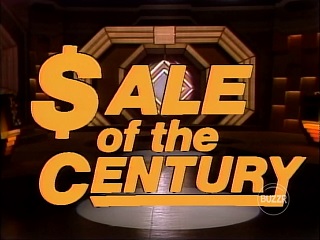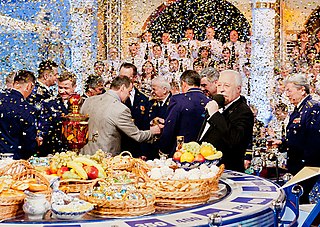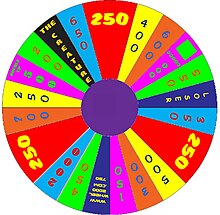
A game show is a genre of broadcast viewing entertainment where contestants compete for rewards. The shows are typically directed by a host, who explains the rules of the game as well as commentating and narrating where necessary. The history of the game shows dates back to the late 1930s when both radio and television game shows were broadcast. The genre became popular in the United States in the 1950s, becoming a regular feature of daytime television.

Sale of the Century is an American television game show that originally debuted on September 29, 1969, on NBC daytime. It was one of three NBC game shows to premiere on that date, the other two being the short-lived game shows Letters to Laugh-In and Name Droppers. The series aired until July 13, 1973, and a weekly syndicated series began that fall and ran for one season.
Concentration is an American television game show based on the children's memory game of the same name. It was created by Jack Barry and Dan Enright. The show featured contestants matching prizes represented by spaces on a game board, which would then reveal portions of a rebus puzzle underneath for the contestants to solve.

Des chiffres et des lettres is a French television programme. It was created by Armand Jammot and tests the numeracy skills and vocabulary of two contestants. It is one of the longest-running game shows in the world, and the inspiration for Countdown on Britain's Channel 4.

Now You See It is an American television game show created by Frank Wayne for Mark Goodson-Bill Todman Productions. The object of Now You See It is to answer general knowledge trivia questions by finding the answers hidden in a grid, similar to a word search puzzle.
Definition is a Canadian television game show, which aired on CTV from September 9, 1974 to March 10, 1989, and recorded at its flagship studios of CFTO-TV at 9 Channel Nine Court in Scarborough, Toronto, Ontario. For most of its run, it was hosted by Jim Perry.

Wheel of Fortune is an American television game show created by Merv Griffin, premiering in 1975 with a syndicated version airing in 1983. Since 1986, the syndicated version has been adapted into various video games spanning numerous hardware generations. Most versions released in the 20th century were published by GameTek, which filed for Chapter 11 bankruptcy protection in 1998.
Mad Libs is an American children's game show based on the book/word game series. It aired on the Disney Channel from July 26, 1998 to mid-1999, and was hosted by David Sidoni. Dick Clark and J. D. Roth produced the show.
Wheel of Fortune is an Australian television game show produced by Grundy Television until 2006, and CBS Studios International in 2008. The program aired on the Seven Network from 1981 to 2004 and January to July 2006, aired at 5:00pm from 1981 to 1989 and from 2004 to 2006 and at 5:30pm from 1989 to 2003, and is mostly based on the same general format as the original American version of the program.

Pole Chudes is a Soviet, later Russian adaptation of the U.S. game show Wheel of Fortune produced by VID, provided with elements of Russian culture and hosted by Leonid Yakubovich. The current rating of the show suggests it is intended for ages 16 and above, unlike the American version which is suitable for all age groups.

Wheel of Fortune is a British television game show based on the American show of the same name created by Merv Griffin. Contestants compete to solve word puzzles, similar to those used in Hangman, to win cash and prizes. The title refers to the show's giant carnival wheel that contestants spin throughout the course of the game to determine their cash and/or prizes.
La Roue de la fortune was the French version of the US game show Wheel of Fortune.

There are two Philippine versions of Wheel of Fortune. The first was aired on ABC aired from November 19, 2001 to May 31, 2002. It was hosted by Rustom Padilla and Victoria London. The second and more recent one was a program that aired on ABS-CBN, with Kris Aquino as main host, while Zara Aldana and Jasmine Fitzgerald alternated as puzzle assistants for each puzzle. Aquino's version started on January 14, 2008, replacing the second season of Kapamilya, Deal or No Deal.
La ruleta de la fortuna or La ruleta de la suerte is the Spanish version of Wheel of Fortune. The first incarnation ran from 1990 to 1992 in Antena 3, the second one from 1993 to 1997 in Telecinco, and then, after a nine-year hiatus, a revival has been made on Antena 3 beginning in 2006. The show also airs internationally via Antena 3 Internacional.
La ruota della fortuna is the Italian version of Wheel of Fortune. The show has run nonstop since 1988 on Canale 5 and Rete 4, and switched from a trilon to an electronic board in the mid-1990s, like the U.S. version. Previously hosted by Mike Bongiorno, the show was hosted by Enrico Papi on Italia 1, and featured Victoria Silvstedt from the French version of the show, La Roue de la Fortune. The Italian version of Wheel will return on the air in 2024 on Canale 5 and will be hosted by Gerry Scotti.
Lykkehjulet is the Danish version of the Wheel of Fortune television game show. Airing in 1988, the show was the first big American game show to be imported to Denmark and it was one of the first successes for Danish broadcaster TV2 when it became Denmark's second TV channel in 1988. The show ran for 3,599 episodes until it was cancelled in 2001 due to declining viewership and a failed attempt at modernizing the format in the final year.
Sqrambled Scuares is a game show airing on HTC Digital Cable in South Carolina. It had been hosted by local personality Buzz Berry since its inception, and produced by Berry's production company BZB Productions. The show taped from Barefoot Landing in Myrtle Beach on Thursdays at 7:00 PM.

Koło Fortuny is a Polish television game show based on the American program Wheel of Fortune and developed for Poland by Wojciech Pijanowski and Paweł Hańczakowski. The show first ran from 2 October 1992 to 1 September 1998. Its second run went from 29 October 2007 to 2009, and its third was debuted on 10 September 2017.

Wheel of Fortune is an American television game show created by Merv Griffin. The show has aired continuously since January 1975. It features a competition in which contestants solve word puzzles, similar to those in hangman, to win cash and prizes determined by spinning a giant carnival wheel. The current version of the series, which airs in nightly syndication, premiered on September 19, 1983. It stars Pat Sajak and Vanna White as hosts, who have hosted the nighttime version since its inception. The original version of Wheel was a network daytime series that ran on NBC from January 6, 1975, to June 30, 1989, and subsequently aired on CBS from July 17, 1989, to January 11, 1991; it returned to NBC on January 14, 1991, and was cancelled that year, ending on September 20, 1991.
Letters and Numbers is an Australian game show on SBS. It is hosted by former newsreader Richard Morecroft, co-hosted by David Astle and Lily Serna. Although it is based on the French game show Des chiffres et des lettres, its structure is similar to the UK version of the show, Countdown - with the titular difference being used to avoid confusion with the Australian music program Countdown.










